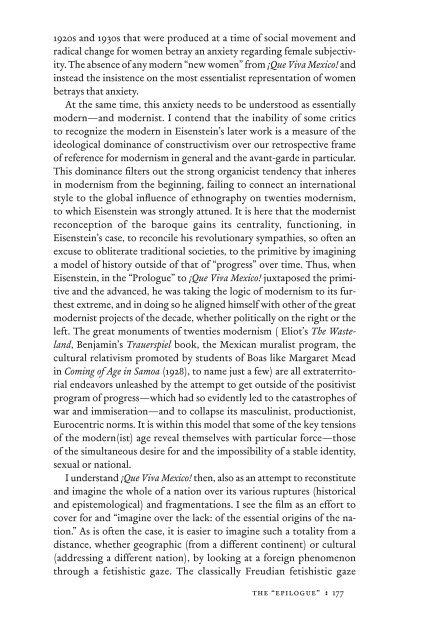In Excess: Sergei Eisentein's Mexico - Cineclub
In Excess: Sergei Eisentein's Mexico - Cineclub
In Excess: Sergei Eisentein's Mexico - Cineclub
Create successful ePaper yourself
Turn your PDF publications into a flip-book with our unique Google optimized e-Paper software.
1920s and 1930s that were produced at a time of social movement and<br />
radical change for women betray an anxiety regarding female subjectivity.<br />
The absence of any modern “new women” from ¡Que Viva <strong>Mexico</strong>! and<br />
instead the insistence on the most essentialist representation of women<br />
betrays that anxiety.<br />
At the same time, this anxiety needs to be understood as essentially<br />
modern—and modernist. I contend that the inability of some critics<br />
to recognize the modern in Eisenstein’s later work is a measure of the<br />
ideological dominance of constructivism over our retrospective frame<br />
of reference for modernism in general and the avant-garde in particular.<br />
This dominance fi lters out the strong organicist tendency that inheres<br />
in modernism from the beginning, failing to connect an international<br />
style to the global infl uence of ethnography on twenties modernism,<br />
to which Eisenstein was strongly attuned. It is here that the modernist<br />
reconception of the baroque gains its centrality, functioning, in<br />
Eisenstein’s case, to reconcile his revolutionary sympathies, so often an<br />
excuse to obliterate traditional societies, to the primitive by imagining<br />
a model of history outside of that of “progress” over time. Thus, when<br />
Eisenstein, in the “Prologue” to ¡Que Viva <strong>Mexico</strong>! juxtaposed the primitive<br />
and the advanced, he was taking the logic of modernism to its furthest<br />
extreme, and in doing so he aligned himself with other of the great<br />
modernist projects of the decade, whether politically on the right or the<br />
left. The great monuments of twenties modernism ( Eliot’s The Wasteland,<br />
Benjamin’s Trauerspiel book, the Mexican muralist program, the<br />
cultural relativism promoted by students of Boas like Margaret Mead<br />
in Coming of Age in Samoa (1928), to name just a few) are all extraterritorial<br />
endeavors unleashed by the attempt to get outside of the positivist<br />
program of progress—which had so evidently led to the catastrophes of<br />
war and immiseration—and to collapse its masculinist, productionist,<br />
Eurocentric norms. It is within this model that some of the key tensions<br />
of the modern(ist) age reveal themselves with particular force—those<br />
of the simultaneous desire for and the impossibility of a stable identity,<br />
sexual or national.<br />
I understand ¡Que Viva <strong>Mexico</strong>! then, also as an attempt to reconstitute<br />
and imagine the whole of a nation over its various ruptures (historical<br />
and epistemological) and fragmentations. I see the fi lm as an effort to<br />
cover for and “imagine over the lack: of the essential origins of the nation.”<br />
As is often the case, it is easier to imagine such a totality from a<br />
distance, whether geographic (from a different continent) or cultural<br />
(addressing a different nation), by looking at a foreign phenomenon<br />
through a fetishistic gaze. The classically Freudian fetishistic gaze<br />
the “epilogue” : 177


